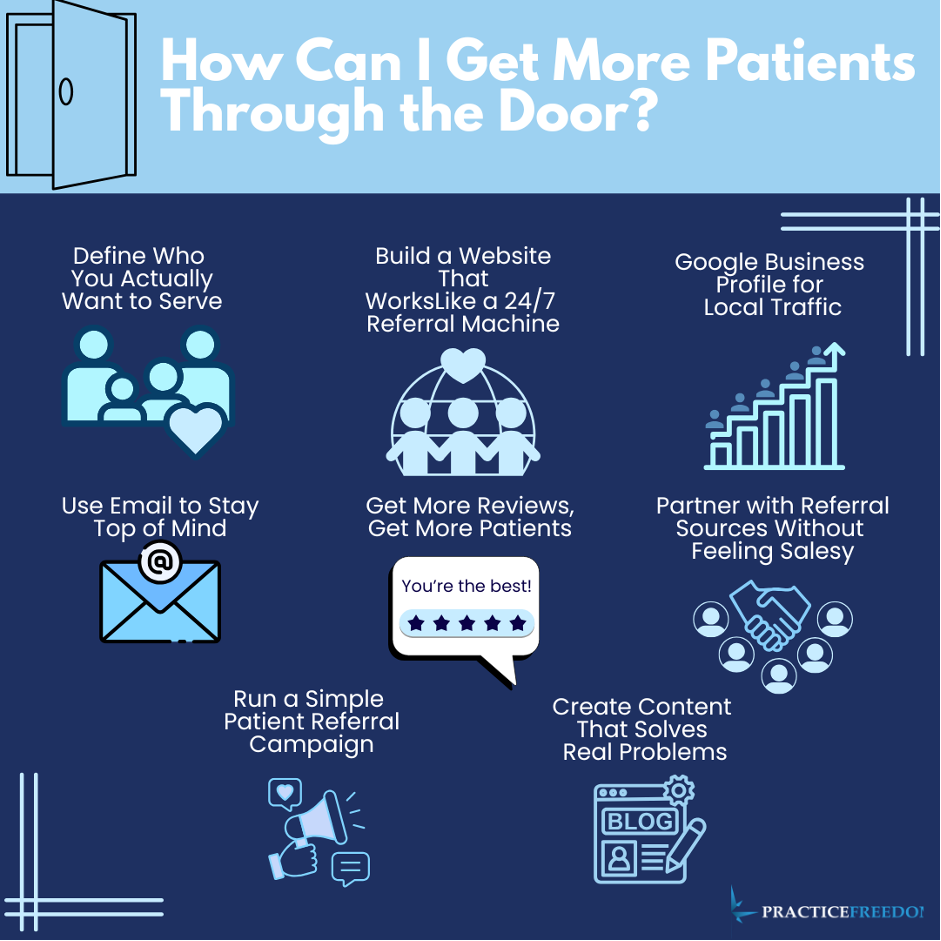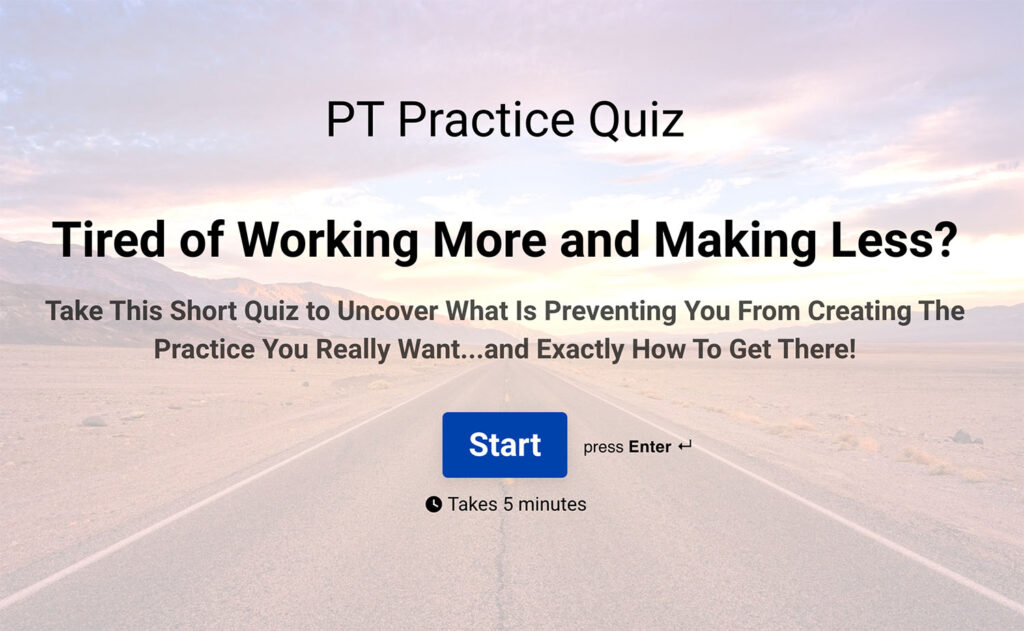Look, I get it—running a private practice is no walk in the park. You’ve spent years mastering your clinical skills, building a team, and maybe even doing your own billing and marketing at some point. But here’s the real question: how do you get more patients through the door, consistently and predictably, without burning yourself out?
If you’re like most private practice owners I talk to, you’re tired of the feast-or-famine cycle. One month the phones are ringing off the hook, the next you’re staring at open slots in your schedule. The problem isn’t that you’re not good at what you do. The problem is that you’re trying to grow your practice using the same strategies you used when you were just starting out.
So let’s change that.
This isn’t about working harder. It’s about building smarter systems to bring in the right patients—consistently.

Step 1: Define Who You Actually Want to Serve
You can’t market to everyone. And you shouldn’t try.
If you want to get more patients into your practice, start by defining your ideal patient. This isn’t just about demographics. It’s about finding the people who benefit most from what you offer—and who are most likely to refer others.
Ask yourself:
- Who are your favorite patients?
- What conditions do you love to treat?
- What are your best clinical outcomes?
When you narrow your focus, your marketing becomes 10 times more effective. Instead of generic messages, you’re speaking directly to the people who are already looking for your help.
Keyword tip: Use terms like sports injury rehab, post-surgical physical therapy, or pediatric occupational therapy—whatever matches your ideal client. These long-tail keywords help you rank better in local SEO and connect with the patients you actually want to treat.
Step 2: Build a Website That Works Like a 24/7 Referral Machine
Most practice websites are digital brochures: pretty but passive. You need yours to work.
A patient-focused, SEO-optimized website should:
- Explain who you help and how you help them
- Include clear calls-to-action (like “Book a Free Consultation”)
- Feature testimonials and social proof
- Be mobile-friendly and fast-loading
Google is usually the first stop for people searching for a solution to their pain. If your site isn’t ranking for local searches like physical therapy near me or back pain treatment in [your city], you’re invisible. (Entrepreneur)
SEO tip: Every service you offer should have its own page. That way, when someone searches for pelvic floor therapy in Austin, your site has a better chance of showing up.
Step 3: Google Business Profile for Local Traffic
If you’re not optimizing your Google Business Profile, you’re leaving new patients on the table.
This is the box that pops up when someone Googles your practice or searches for services in your area. It’s packed with information: your location, hours, reviews, photos, and more. Google uses it to determine local rankings.
Here’s what you can do:
- Fill out every field in your profile
- Add updated photos of your clinic and team
- Get and respond to reviews regularly
When optimized correctly, your Google Business Profile can drive a high-intent traffic—people actively looking for help right now.
Step 4: Use Email to Stay Top of Mind
Most practices don’t have a patient database. If that’s you, you’re missing out.
Patients who already know and trust you are your best marketing asset. They’re the ones most likely to come back, refer friends, and leave reviews. But they won’t think of you if they don’t hear from you.
Build a simple email list with the names and emails of past patients. Send helpful content regularly:
- Tips for staying pain-free
- Success stories
- Seasonal health reminders
- Special offers or workshops
You don’t need to be fancy. You just need to be consistent.
SEO tip: Include links back to your website and blog to improve traffic and ranking over time.
Step 5: Get More Reviews, Get More Patients
Online reviews are the new word-of-mouth. And the more high-quality reviews you have, the more likely you are to show up in search results—and earn trust from potential patients.
Make it easy for people to leave a review:
- Ask at the right time (when they’re feeling great)
- Send them a direct link to your Google profile
- Train your team to ask during checkout or follow-ups
You don’t need hundreds of reviews overnight. Just start building slowly and consistently. A steady stream of positive feedback tells Google—and future patients—that your practice is the real deal. (Forbes)
SEO tip: Include the service and location in your replies to reviews when appropriate. Example: “Thank you, Sarah! We love helping postpartum moms recover with pelvic floor therapy here in Denver.”
Step 6: Partner with Referral Sources Without Feeling Salesy
Referrals from doctors, trainers, and other professionals are still one of the best ways to grow your patient base. But most practice owners don’t have a system for it. (Bloomberg)
Here’s what works:
- Create a simple one-sheet that explains who you help and why it matters
- Reach out with a clear reason for connecting (“I specialize in post-surgical rehab, and I’d love to support your patients after knee replacements.”)
- Follow up every few weeks with value—patient updates, educational content, or event invites
This isn’t about selling. It’s about relationships. Be consistent, be helpful, and you’ll stay top of mind.
Step 7: Run a Simple Patient Referral Campaign
Want a low-cost way to get more patients fast? Tap into your current network.
Run a “Patient Appreciation Month” where you reward patients who refer friends or family. Offer a small thank-you—maybe a free t-shirt, a gift card, or entry into a prize drawing.
People love helping people. They just need a reason to take action.
Keyword tip: Promote this campaign on your website and social media using terms like referral program, refer a friend, and thank you for your referral.
Step 8: Create Content That Solves Real Problems
Blogging might sound old-school, but it still works—when you do it right.
You’re not writing for other clinicians. You’re writing for patients. Think of the most common questions people ask before, during, or after treatment, and turn those into blog posts.
Examples:
- “Should I get an MRI before starting physical therapy?”
- “Why does my shoulder still hurt months after surgery?”
- “Top 5 stretches to relieve lower back pain at home”
Use keywords naturally, write in plain English, and aim to be helpful. Over time, this content builds authority, drives organic traffic, and educates potential patients before they ever walk in your door.
Getting more patients through the door isn’t magic—and it’s not about working longer hours or offering discounts you can’t afford.
It’s about building a repeatable system. One that connects with the right people, delivers value, and positions your practice as the obvious choice in your community.
If you’re tired of trying to figure all this out on your own, that’s exactly why I created Practice Freedom U. We help private practice owners like you treat less, earn more, and build a business that doesn’t depend on your constant presence. Whether you’re struggling with getting new patients, managing a growing team, or just trying to take a real vacation without checking your phone every hour, we’ve got tools and coaching that work. Because you didn’t open your practice just to own your job—you opened it to create a life of impact, freedom, and fun.
You’ve already done the hard part: you opened your practice, you built a team, and you’ve changed lives.
Now it’s time to grow—not by doing more, but by doing the right things.
————————————————————-
Are you ready for a coach? Join the hundreds of physical therapy owners who are building the practice of their dreams with the support, guidance and direction of a Practice Freedom U Coach. Take the first step towards creating a business that sets you free by scheduling a Discovery Call



